
| Bogong Moth (one synonym : Agrotis spina Guenée, 1852) NOCTUINAE, NOCTUIDAE, NOCTUOIDEA | (donherbisonevans@yahoo.com) and Stella Crossley |

| Bogong Moth (one synonym : Agrotis spina Guenée, 1852) NOCTUINAE, NOCTUIDAE, NOCTUOIDEA | (donherbisonevans@yahoo.com) and Stella Crossley |
Bogong Moths have an important place in Australian history.
Early instars of the Caterpillars are cream coloured. Later instars are green with a pattern of pale lines running along the body and across between the segments. They have a jet black head shield, and a kidney-shaped prothoracic shield and anal plate. Small black dots are scattered along the sides, marking the positions of primary setae. As the caterpillars grow, the final instars become darker, until they end up grey-brown with a paler ventral surface. Some become almost black, and some pale brown with an orange tinge, even from the same batch of eggs. At the base of a foodplant, they construct a burrow in the soil. In this they hide by day, and climb the plant to feed by night. They are a pest on a wide variety of agricultural crops, such as:
In captivity, we fed our specimens on:
The natural food plants are broad leaved weeds such as:
They do not thrive on grasses (POACEAE), even though they attack young cereals. Their habit of feeding on crops makes them an agricultural pest.
They grow to length of about 5 cms. They pupate in a cocoon in their burrow under the soil.
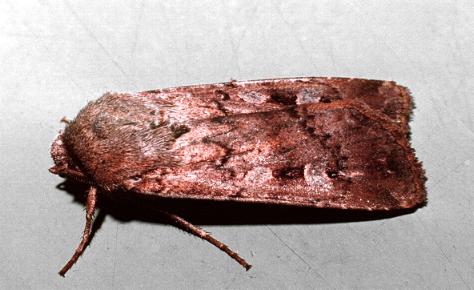
The adults emerge about four weeks later. They vary in colour from light brown to almost black. However, all Bogongs have characteristic marks on each forewing: namely a dark arrow-marked streak, broken by one round pale spot and one comma-shaped spot. The hindwings are light brown with a darker border. At rest the moth holds its wings like a tent over its body. The males have feathery antennae, and the females have thread-like antennae. The moth has a wingspan of about 5 cms.
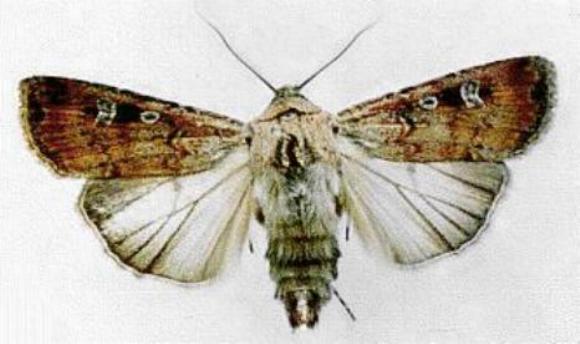
The main breeding ground of the Bogong is the pasture land west of the Great Dividing Range. However, during summer, the high temperatures make the plains unfavourable for the Bogongs. The adults that emerge in spring migrate south particularly to the cooler high country of the Great Dividing Range. They particularly congregate around the area of Mount Bogong in the Alpine National Park. The migration has been the subject of an ABC film: "Night of the Bogongs".
The method orientation for their journey has been the subject of speculation. Experiments have shown that the the moths seek a high peak on the horizon, and also use the direction of the earth's magnetic field to guide their migration.
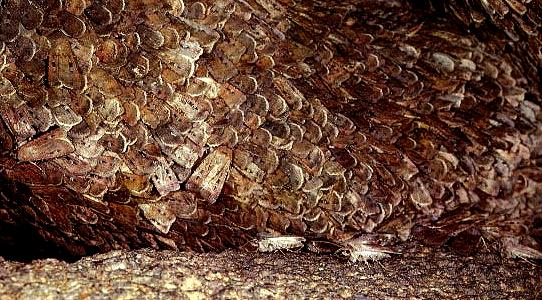
During summer, from November to February, they congregate in such numbers in the caves in the Australian Alps that they completely cover the floors of these caves. Josephine Flood in her book "The Moth Hunters" describes how the moths rest in thick clusters, each moth with its head under the wings of the one in front. The Aborigines were well aware that the moths congregate in these caves in summer. They also knew that the bodies of the moths are highly nutricious. Many Aborigines moved into the Alps in November, collecting, cooking, and feasting on the moths. These festivals still continue. Using a smouldering piece of brushwood, the Aborigines knocked the moths into a container made of bark or kangaroo skin, or a net made of kurrajong fibre. By roasting the moths in hot ashes, the wings and legs were separated from the bodies. The bodies were then mashed to make "Moth Meat", which was eaten. It is said to have a nutty taste, somewhat like walnuts.
Sometimes, during the migratory flights of the Bogongs, winds blow them over the dividing range to the eastern seaboard. This is the cause of the intermittent "Bogong Plagues" in the cities of Canberra, Sydney, and Melbourne.
In the mountains, they aestivate, waiting in caves and crevices until the autumn. Then they return to the plains to mate and lay their eggs. The eggs are laid typically low on a foodplant near the soil.
Thus the species may be found in:
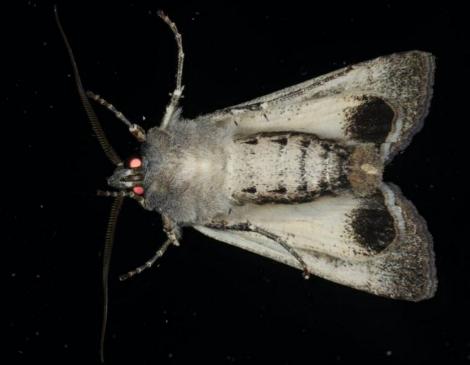
Our specimens were reared from eggs laid by a female captured at the kitchen window in Melbourne one January.
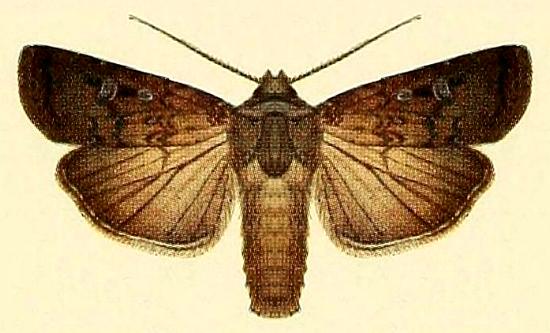
On the way south, the moths pause to alight on flowers to suck nectar for energy. On the way north in Autumn, there are fewer flowers, and the moths have been observed sucking the honeydew exudate of Lerps (Homoptera).
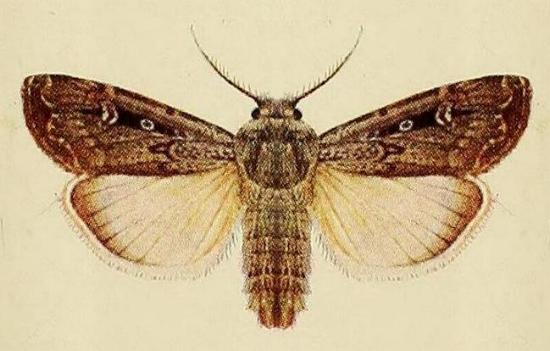
A Bogong was unjustly blamed for embarrassing Yvonne Kenny while she was singing the Olympic Hymn in the closing ceremony of the 2000 Sydney Olympic Games, as it landed for a while on her bosom. In fact there were several moth species including Bogongs attracted to the brilliant arena floodlighting that evening, and the one on Yvonne's dress appeared actually to be a hawk moth of the species : Hippotion scrofa.
The Bogong is also being blamed for bringing toxic levels of arsenic into the Victorian Alps. Population numbers have declined in recent years, and the arsenic, agropesticides, and global warming have all been blamed for this.
Further reading :
Jean-Baptiste Alphonse Dechauffour de Boisduval,
Faune Entomologique de L'Ocean Pacifique,
in M. J. Dumont d'Urville:
Voyage de Decouvertes de la Corvette l'Astrolabe,
Division 7, Lepidopteres Part 1 (1832), p. 240.
Ian F.B. Common,
Moths of Australia,
Melbourne University Press, 1990,
figs. 50.5, 55.15, pp. 42, 44, 51, 56, 61, 64, 333, 467.
Pat and Mike Coupar,
Flying Colours,
New South Wales University Press, Sydney 1992, p. 66.
Ken Green,
The return migration of Bogong Moths,
Agrotis infusa (Boisduval) (Lepidoptera: NOCTUIDAE),
from the Snowy Mountains, New South Wales,
The Australian Entomologist,
Volume 33, Part 1 (March 2006), pp. 27-30.
Peter B. McQuillan, Jan A. Forrest, David Keane, & Roger Grund,
Caterpillars, moths, and their plants of Southern Australia,
Butterfly Conservation South Australia Inc., Adelaide (2019), p. 167.
Peter Marriott & Marilyn Hewish,
Moths of Victoria - Part 9,
Cutworms and Allies - NOCTUOIDEA (C),
Entomological Society of Victoria, 2020, pp. 24-25, 30-31.
Paul Zborowski and Ted Edwards,
A Guide to Australian Moths,
CSIRO Publishing, 2007, pp. 198, 200-203.
 caterpillar |  butterflies |  Lepidoptera |  moths |  caterpillar |
(updated 15 April 2013, 22 October 2025)